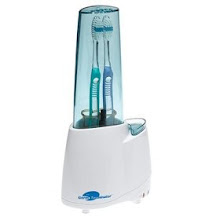The typical household bathroom is popularly known as "the dirtiest room in the house" for a reason. Even if you take care to neurotically clean the bathroom in your house every 2 to 3 days, there is no doubt that loads of germs, blood, and other bodily fluids are flying around as a result of hand-washing, toilet flushing, bathing, shaving, or any of the other grooming and personal hygiene activities that we carry out inside this little room.
Aside from the "bacterial mist" that is evident after each toilet flush and can stay in the air for at least two hours, the highest incidence of nasty bathroom germs actually occurs within and around the sink! That's right, the same place where you wash your face and hands, and brush your teeth every day!
How many of us rest our toothbrushes on the surfaces of a dirty sink, or how many of us have had our toothbrushes slip into the same dirty sink or even the floor? If you are like most people, the toothbrush is conveniently stored on or next to the the sink, contained within the infamous "community cup" holding the toothbrushes of every person in the household. It's here in the decorative and grimy family toothbrush cup that toothbrushes can actually share germs. This convenient storage habit is why the Journal of the Canadian Dental Association has stated that "toothbrushes can transmit disease." In technical terms, this is described as "cross-contamination.

No matter how much of a germ freak you may call yourself or how often you clean your bathroom and practice techniques to limit the toilet "aerosol effect" and control the amount of sink germs that reach your toothbrush, unfortunately, there is virtually no escaping toothbrush germs. Even new toothbrushes aren't safe. A study published in the Journal of the Oklahoma Dental Association found that 4 out of 5 (80%) brand new toothbrushes from one manufacturer were contaminated right out of the box!
Instead of buying a new toothbrush each time you brush, as they are getting more and more expensive and some are contaminated anyway, why not sanitize your toothbrush and kill the germs? Now that there is a way to solve this dirty little problem, you can easily use a clean, sanitized toothbrush, and protect your immune system from all of the nasty germs living on your toothbrush bristles. It just makes sense.




